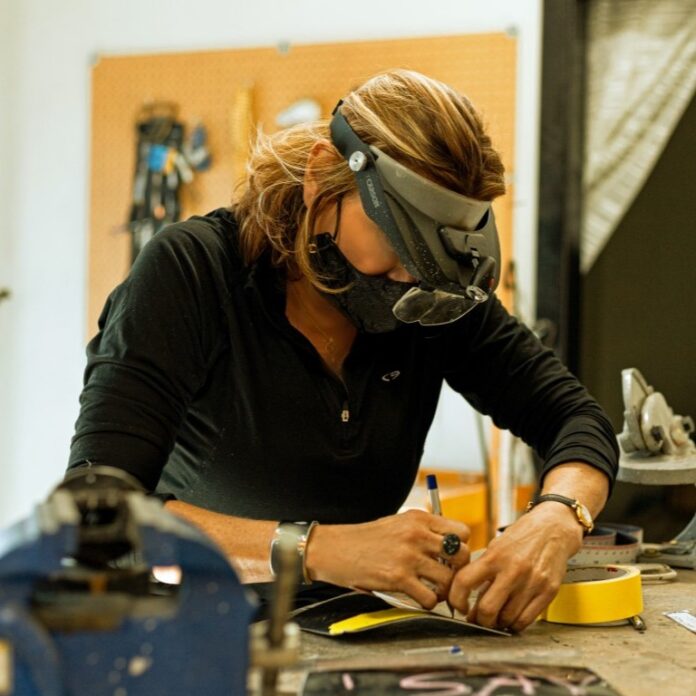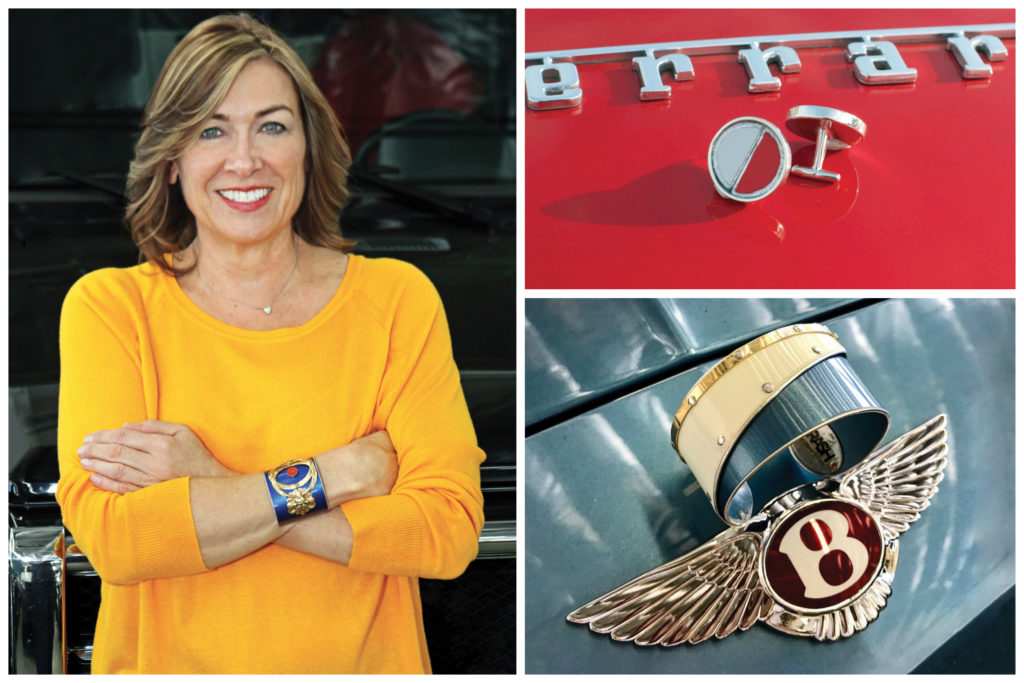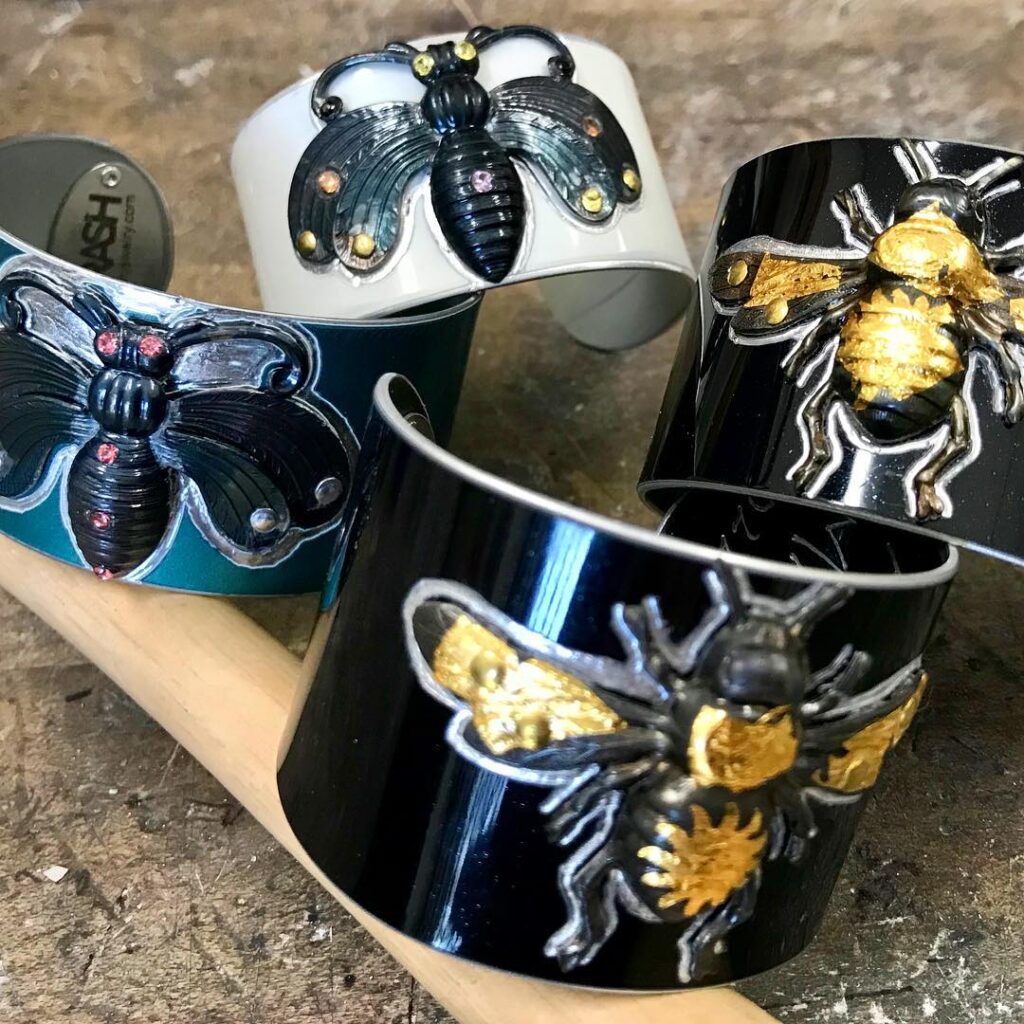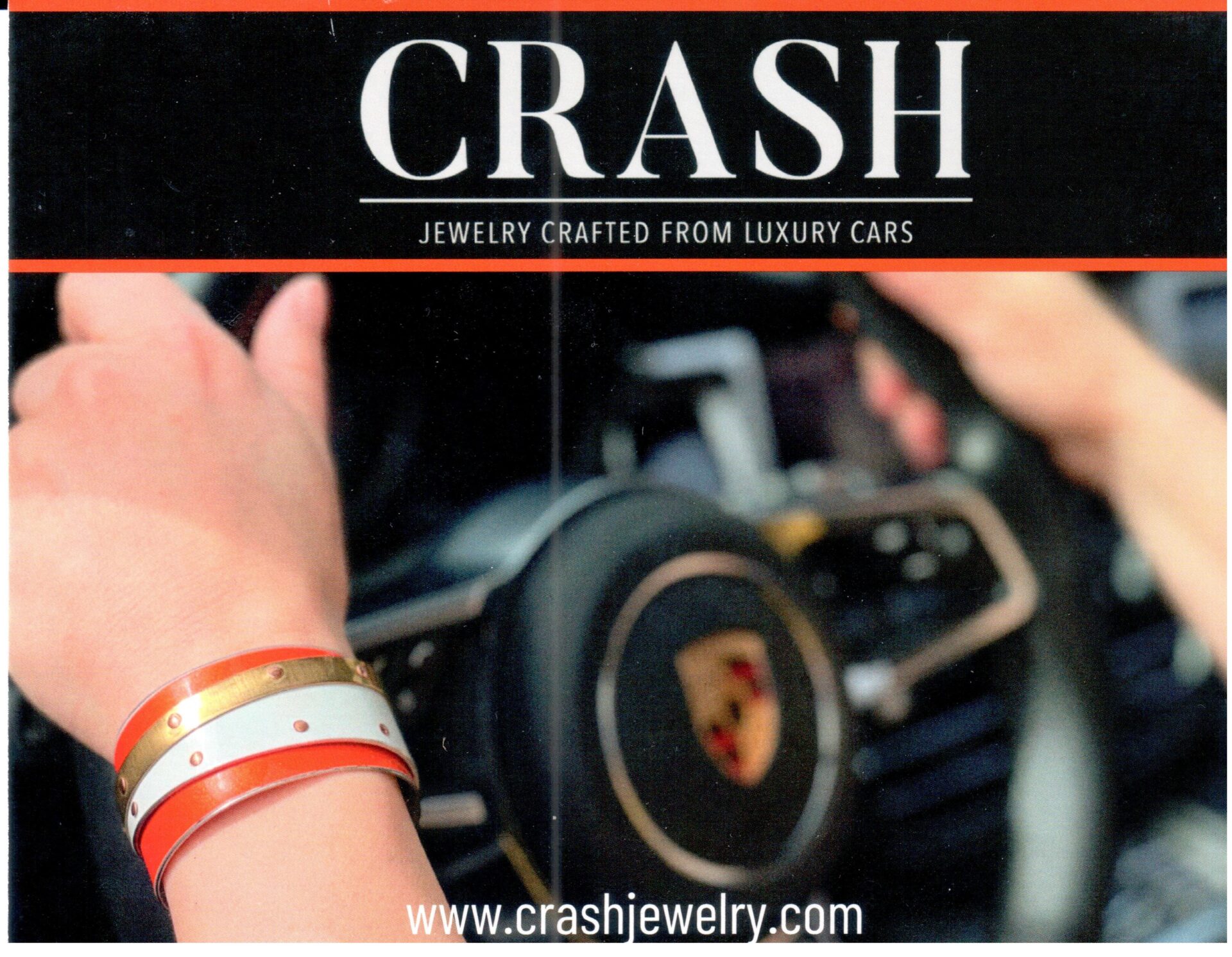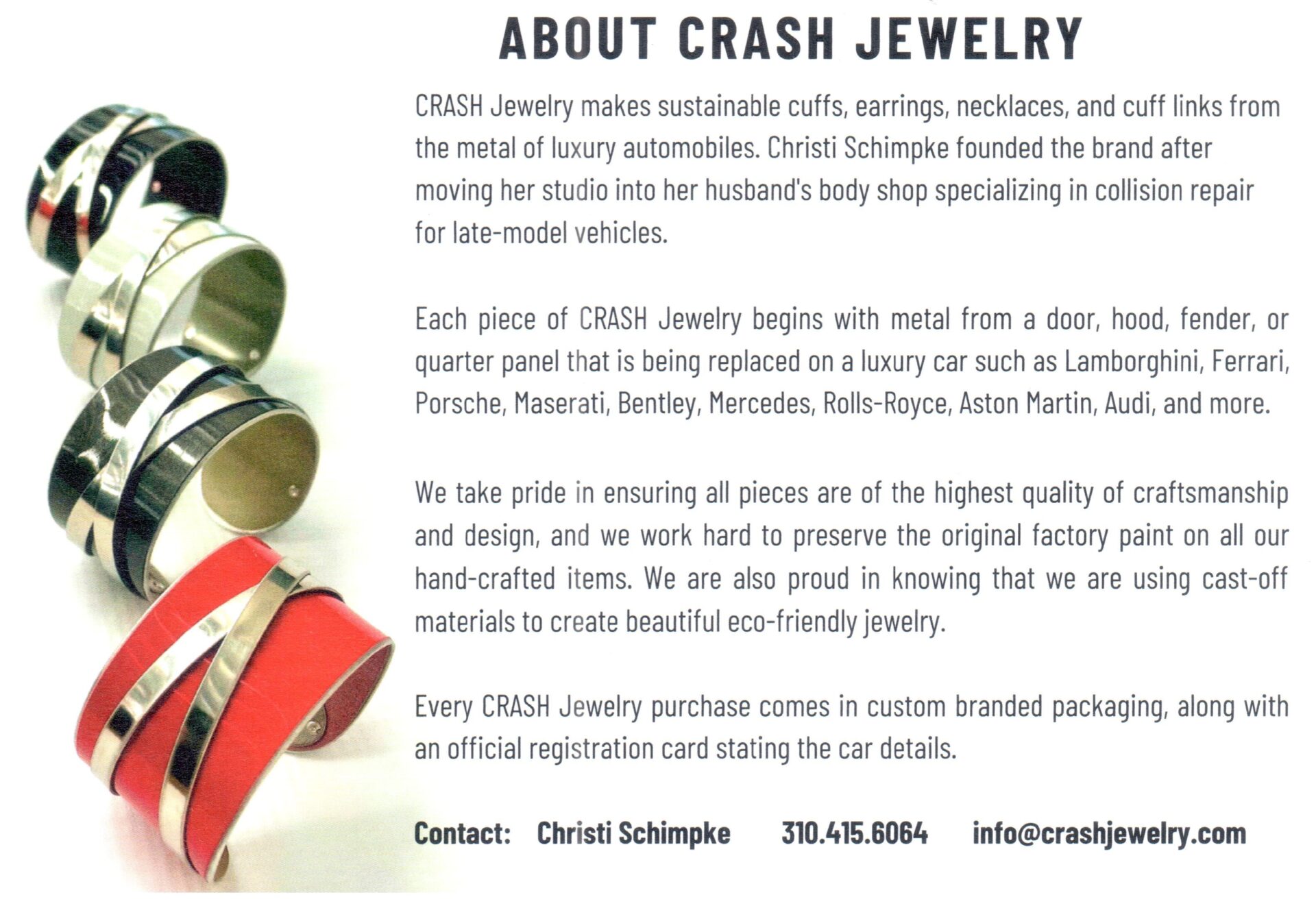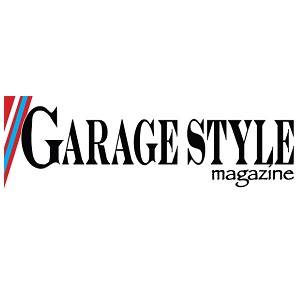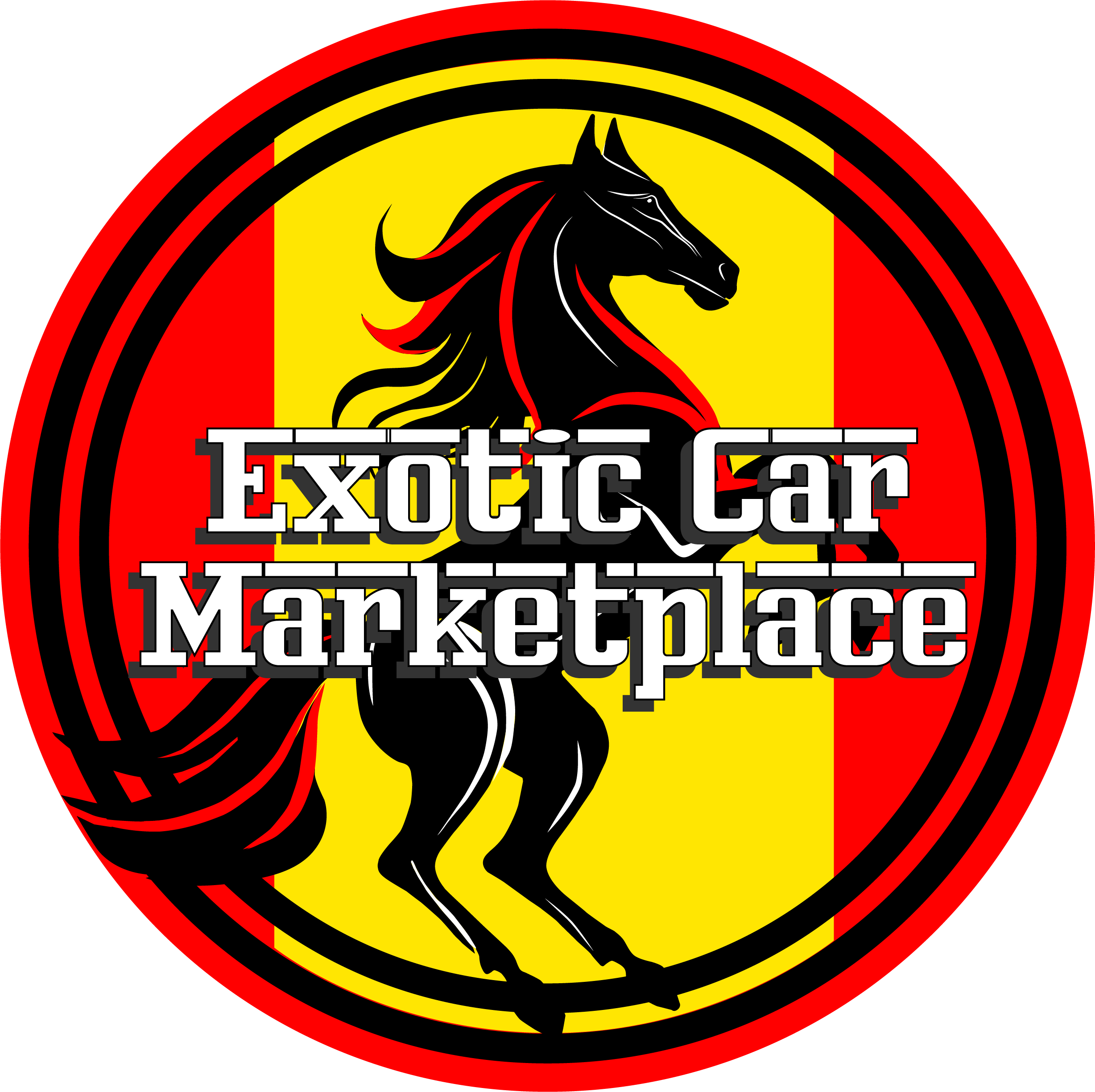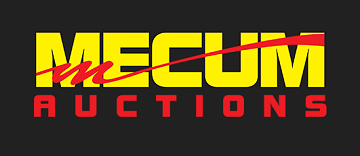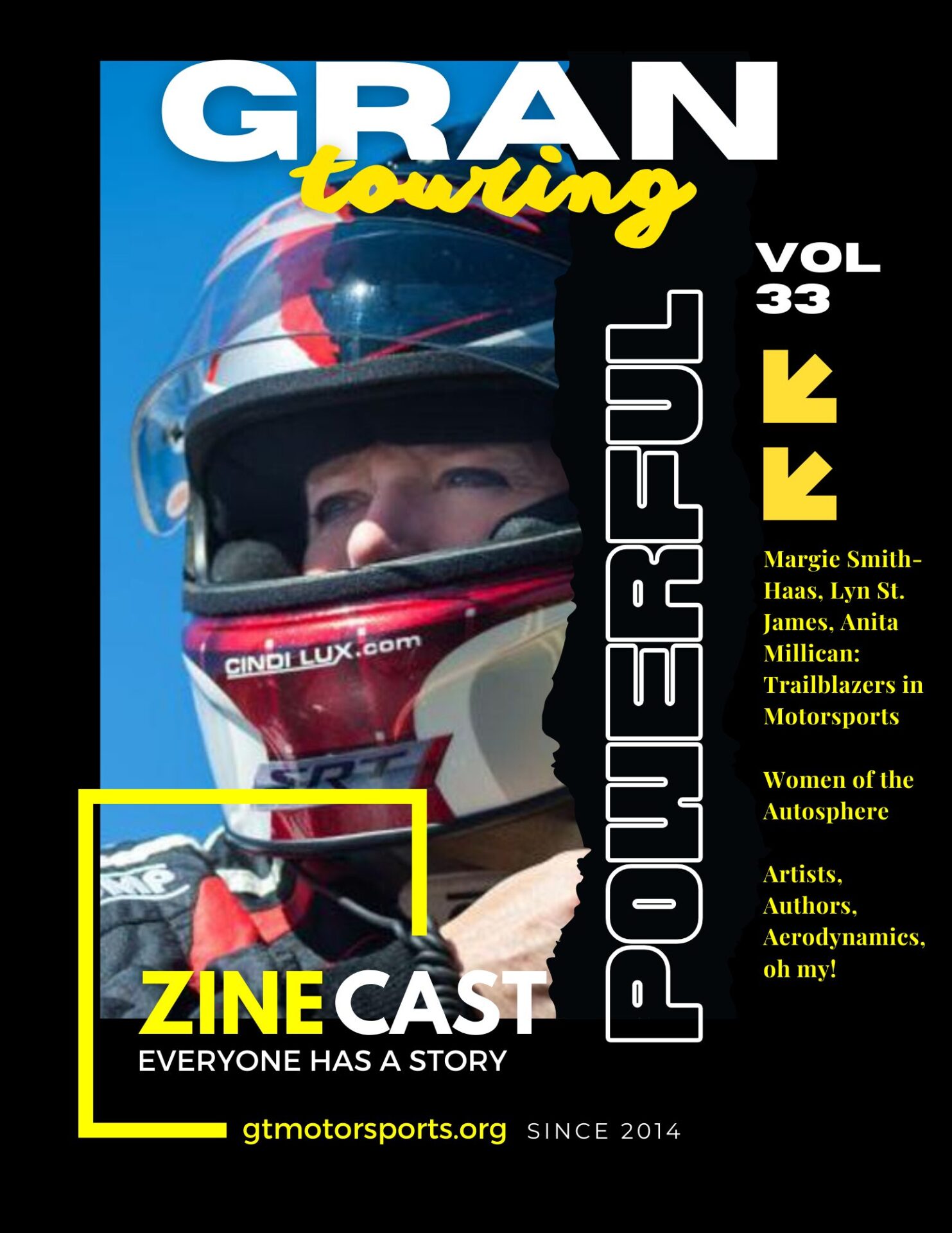Our guest has a background in art history, and began metal working when she discovered her passion for jewelry fabrication a few years ago. Today she makes sustainable uni-sex jewelry from the metal of luxury automobiles like Aston Martin, Porsche, Maserati, Mercedes-Benz, Lamborghini, Audi, Bentley, and more.
Christi Schimpke’s, vision for CRASH materialized when she was working in her garage studio. During breaks from work, she observed the gorgeous cars that arrived for repair and wondered what happened to the cast-off metal. After many months of experimentation, she discovered her own unique process of cutting, bending, and sanding the scrap metal, and CRASH Jewelry started to take shape. And she’s here with us tonight to tell us the rest of the story…
Tune in everywhere you stream, download or listen!
 |  |  |
- Spotlight
- Notes
- Transcript
- Highlights
- Learn More
Spotlight
Christi Schimpke - Founder for CRASH Jewelry

CRASH Jewelry makes sustainable uni-sex jewelry from the metal of luxury automobiles. We source metal from Porsche, Maserati, Mercedes-Benz, Lamborghini, Audi, Bentley, and more.
Contact: Christi Schimpke at info@crashjewelry.com | N/A | Visit Online!![]()
![]()
![]()
![]()
![]()
Notes
- Let’s talk about The who/what/where/when/how of Christi – how did you get into cars?
- How did CRASH Jewelry get started?
- Where does the source materials come from?
- Outside of the cuffs … What types of items have you been able to create from the pieces you’ve acquired
- How has the jewelry inspired people?
- One of the coolest features about the jewelry isn’t just the piece, but what it comes with. Can you describe that for our audience?
- How does one go about getting CRASH Jewelry? Can someone have a piece commissioned?
and much, much more!
Transcript
Crew Chief Brad: [00:00:00] BreakFix podcast is all about capturing the living history of people from all over the autosphere, from wrench turners and racers to artists, authors, designers, and everything in between. Our goal is to inspire a new generation of petrolheads that wonder, how did they get that job? Or become that person.
The road to success is paved by all of us because everyone has a story.
Crew Chief Eric: Tonight’s guest has a background in art history and began metalworking when she discovered her passion for jewelry fabrication a few years ago. Today she makes sustainable unisex jewelry from the metal of luxury automobiles. like Aston Martins, Porsches, Maseratis, Mercedes Benzes, Lamborghinis, Audis, Bentleys, and many, many more.
Lauren Goodman: Christy Schimke’s vision for Crash materialized when she was working in her garage studio. During breaks from work, she observed the gorgeous cars that arrived for repair and wondered, what happened to the cast off metal? After many months of [00:01:00] experimentation, she discovered her own unique process of cutting, bending, shaping, and sanding scrap metal.
And Crash Jewelry started to take shape, and she’s here with us tonight to tell the rest of her story.
Crew Chief Eric: And with that, let’s welcome Christy to Break Fix.
Lauren Goodman: Hello, thank
Christie Schimpke: you.
Crew Chief Eric: And joining us tonight is our newest co host to Break Fix, Lauren Goodman, supervising producer of media and exhibitions from the REVS Institute.
So welcome back, Lauren. Lovely to be here. Well, like all good break fix stories, there’s a superheroine origin story. So, Christy, tell us about how you got into the world of cars, how you stepped into the autosphere, and how crash jewelry all started to come about.
Christie Schimpke: I was working previously in the museum field in education.
My background’s in art history, so I was always sort of a frustrated artist. I was really tired of the bureaucracy of these big institutions. When I met my husband a while back, he has a body shop here in West Los Angeles. I had never been in a body shop. I didn’t really [00:02:00] know much about cars, especially luxury high end cars.
But as the marriage went on, I started taking metalsmithing classes and just absolutely fell in love with it. I was like, this is what I want to do. This is exactly what I want to do. And I was just making more traditional types of gold, silver, metal smithing. You said your background was art
Lauren Goodman: history and fine arts.
Did you grow up in a car culture? Are you surprised by this
Christie Schimpke: new connection that you have? My brother was always into muscle cars. I never had a super nice car. I’m absolutely surprised. It was a departure for me because I didn’t really know anything about it. And then when I did start doing it. It was more about the tactile nature of it is about the paint and how it’s going to behave.
But as I’ve been doing it, I’ve learned more and more and more about cars. And my husband is great because if I have a question, even though it’s on a small scale about jewelry, it can extrapolate. And we can talk about, well, this is how, when we’re doing this particular thing, when we’re rebuilding this, we use these rivets.
And [00:03:00] then I can maybe apply that technique or whatever to the jewelry. And a lot of times it’s been very, very useful, but yeah, now the car community, I love it. I’ve met so many great people. I feel like I know so much more about cars. My life has completely changed, but after a while I moved my studio into one of the garages, which is where I am now at work.
I was still making the silver and gold jewelry, but I wasn’t making anything from the cars yet. I would see these cars come in and was always admiring them. And especially the paint. Which reminded me of enamel, I just started thinking like, you know, I wonder, I wonder where this metal goes. I wonder if I can make jewelry from it took a while, you know, it was just one of those thoughts.
So I started doing that. And after a lot of trial and error, it took a little while to get there and it’s been about 10 years, but we finally got to the point where I’m just making crash jewelry. I’m not doing. The silver and gold any longer.
Crew Chief Eric: Tell us about those early trials and errors. What was your first successful piece, especially in terms [00:04:00] of harvesting the metal from these automobiles?
Christie Schimpke: We had no idea really what we were doing. So it’s interesting because when I first started doing this, I thought, Oh, you know, everything’s aluminum practically that we’re getting in. It’s going to be piece of cake to bend aluminum, but it’s the opposite. It’s very, very, very tough metal. And that was a real problem trying to manipulate and bend that metal into a curve.
So the steel was much more malleable, but sharper.
Lauren Goodman: I’ve only had to deal with cut sheet metal working on my own car once, and it ended up with me needing like six stitches. First of all, do you have any good stitch stories? But also, this must be part of your artistry, that you’re able to deal with these materials without losing a hand.
Christie Schimpke: Just very careful. I mean, I’ve had a tetanus shot because I’ve cut myself with metal. I cut myself all the time. I pull out little metal splinters from my hands. Yeah, my hands are a mess. You know, I wear gloves a lot of the time, but it needs to be tactile. I need to feel the surface when I’m shaping and when I’m sanding.
If you’re going to wear it, I want to know that, okay, I don’t want this to hurt Lauren’s wrist. You know, [00:05:00] I want it to be easy to go on, easy to come off. So it’s very important that we get everything. smooth as we can get it along the edges. It’s just a matter of taking your time and making sure you don’t have any burrs or anything like that.
It’s either aluminum or steel, and these are new cars. We don’t work on classic cars or anything like that. It was all about preserving the factory paint, keeping it intact. So Dan would start cutting it up and he would cut up a hood and they give me smaller pieces, which I would then take. And it was very, very crude.
I mean, I had to use a bench shear, which I still do. We were using a little belt sander to sand. We were using rivets that we use the little tiny riveter with our fingers and then trying to bend things. The paint would crack. The paint would come off, especially where we drill holes for rivets. The pressure points there.
We had to say, okay, well, first of all, we can’t drill and bend. We’re going to have to drill, bend, then rivet. So everything had to be made on a curved surface, most things, the cuffs.
Crew Chief Eric: So a [00:06:00] cuff is a wide bracelet, right? So
Christie Schimpke: we make anything from a half an inch up to three inches and yeah, we leave a half an inch for the opening, which was a challenge in and of itself since nothing was really automated.
I’m very, very much of a Luddite process. So in the very beginning, I guess the first piece I made was from a Mercedes SL, a beautiful car and the color was Disegno Matte Gray, beautiful sort of a khaki gray color. Just made a real simple cuff and after that we just kept going on.
Lauren Goodman: Your harvesting was essentially, to some people, junk off of these beautiful automobiles.
The kind of work your husband does in his shop. We’re not talking about like serious accidents. We’re talking about bodywork, right? In case anyone was worried, does this come from a serious accident?
Christie Schimpke: Yeah. So we work with dealerships, Beverly Hills and Santa Monica. So we get a lot of cars that come in that had been maybe some lot damage or valet damage.
We work with concierge services. So we get a lot of beautiful high end cars that are just coming in to say, [00:07:00] have a quarter panel replaced. So if a car is It’s total, it’s not ours. We can’t touch it. It belongs to the insurance company straight away. So I see the cars when they come in, kind of look at the damage, mostly fender benders.
And again, if it’s total, I can’t touch it.
Lauren Goodman: You see an opportunity there because otherwise it goes to a landfill. So you say we could do something beautiful with this,
Christie Schimpke: right? There are people that do recycle the metal that will come around and find scrap. But yeah, to some people it could be considered like, Oh, you know, well that’s not really worth anything, you know, because that’s just.
Scrap, but to car aficionados or to even anybody really I mean when you tell the back story and you talk about it And you talk about they came from a Ferrari 360 Challenge Stradale and Rosso Corsa It’s just like their eyes just you know light up
Lauren Goodman: It’s interesting to me because this is something that goes on at Rev’s Institute in the workshop is when they look at conserving cars Some of the conservators who come in are fine art conservators.
They come from a fine art museum [00:08:00] background. In fact, one of my favorite people, Dr. Gundula Toot, she came from just a purely, like, preserving painting background. I got interested because Picasso enjoyed using auto paints in his work, and she became interested in the properties of auto paint. When she comes in, she’s looking with the eye of somebody with an art history and fine art background, but so many of those same principles are really applicable in collecting really special cars.
Christie Schimpke: Really, it is an art, but just reminded me what Lauren was saying about gaso and automotive paint. This is another story about a gentleman in Sydney, Australia, Ron Goodman. He is a really well known Porsche restorer, and he drives a lot of 356s. And he sent me parts of his car that he had an aboriginal painter paint.
Because he was taking it into the Outback to raise money for Sydney Children’s Hospital. So he gave me a part of the car with the aboriginal painting on it, and we made items for them to auction off to raise money for the hospital.
Crew Chief Eric: Having worked on my own race cars, you know, a lot of [00:09:00] times you got to pull a fender, you got to pull a hood off.
The underside of that metal
Christie Schimpke: is not the nicest
Crew Chief Eric: metal. It’s not nearly as finished as the outside. People just think, Oh, the fender, you know, it’s the same inside as it is out. And it’s not. And so I wonder, let’s say you’re talking about the cuffs. How do you treat the piece to make it comfortable, not only just on the edges, but to the wrist?
And you don’t end up having like a reaction. Some people have different reactions to metal types and things like that. So what are you doing to treat the pieces?
Christie Schimpke: It’s interesting you say that because the doors are the worst doors, hoods, there’s all this infrastructure that you have to deal with to take out, separate it.
And that in and of itself is a pain. huge pain. And then a lot of the cars have this really thick, like sound proofing, hard rubber that we try to heat slowly with a heat gun. And we basically have to take a chisel and a hammer and just get it off as much as we can. Some of it comes off easily with a chisel.
Some, we just have to keep reheating it and trying again. A lot of times we [00:10:00] just grind it off if we can, but it’s always interesting. Seems to be the same cars that use the same materials over and over again that we always hate. We get the inside, the back that touches your skin as clean as possible. We do a lot of sanding, a lot of grinding.
And we also engrave the name of the car on the inside, give it a VIN, not an actual VIN, but it’s our VIN so that we have a reference. If you wanted to reorder, I’d say, Hey, you know, what’s your VIN? And then I would know what size you want.
Lauren Goodman: It looks like almost everything has to do with the body parts that are made out of aluminum or sheet metal.
Have you thought about incorporating or planning to do anything with carbon fiber or other kinds of. Hard materials that come out of the car, be they interior or exterior. I can’t
Christie Schimpke: work with carbon fiber. It just breaks if you try and bend it. Can’t really work with that.
Crew Chief Eric: What about ABS plastics, like bumpers and stuff?
Christie Schimpke: Nah, it’s just nasty. I, I have worked with Corvette Museum. They sent me a bunch of C8 panels.
Crew Chief Eric: Which are fiberglass.
Christie Schimpke: I, I said, I don’t think this is going to work because it can’t bend it. [00:11:00] So everything was going to have to be flat. So the way we got around that was grinding everything down. So it’s just a very thin layer of this stuff on the back and the paint on top.
And then I would set it in resin because you don’t want that next to your skin. Sure. That’s as good as I can get with Corvette. So, and I, I have tried bumpers before. It’s, it’s not much fun because it is plastic and it’s the same concept. I can’t bend it. It’s just, it’s gotta be flat.
Crew Chief Eric: To Lauren’s point.
Have you thought about maybe branching into using, let’s say. Convertible tops or the leather from the seats or door cards or something like that from a wrecked car.
Christie Schimpke: I did use some upholstery in the beginning to line the insides. It was just so intensive to get the leather inside and to get it perfect that if I was going to charge what it cost me to make it, nobody would buy it.
But yeah, as far as other things, other bits of the car, I haven’t, Oh yeah, I did use a window sash from my box. It’s aluminum and I’ve made some things with that and I’m [00:12:00] making some earrings now. So that’s been really great. There’s not a whole lot other than the car panels itself because it’s about preserving that paint.
However, we are branching into fashion. We’re making butterflies. that are made from a Porsche, two different Porsches, and we’re going to put pins on the back and then we’re going to bend the wings up. And then I am wearing these on a special suit that I’m having made for me to the motor car cavalcade.
So it’s going to be my butterfly suit. I love that. That’s amazing. Yeah. And I was thinking these would also be good on shoes. Like you could put them on shoes if you add a little clips too.
Crew Chief Eric: Or maybe for your hair as well.
Christie Schimpke: Absolutely. Like a comb.
Crew Chief Eric: Mm hmm. Talking about bending the metal. A lot of times the paints will crack.
There’s different paints out there. Do you have to apply a lot of heat in order to get the paint to stay together? And how are you protecting the edges? Is there some sort of again, urethane or something that’s keeping it from peeling back? Without giving away any secrets.
Christie Schimpke: Yeah, we are using [00:13:00] heat, but very slowly.
It’s a very slow process. We heat it for a little bit. Then we start to bend it. We heat it. We bend it. We heat it. We bend it. What we’re doing now is we’re using a laser engraver. I have a guy that works with me, Brian Bischoff, and he is an engineer and he’s figured out how to use a very powerful laser engraver to actually.
burn through the paint and expose the bare metal underneath. So what we’ll do a lot of times is we will burn the shape of the cuff. So it creates like a little divide. So then we, when we cut it out, we make sure we cut outside that little line so that the paint can stay within the boundaries of that laser line.
So that when we are bending it or sanding it, it doesn’t crack. It does sometimes. Red paint is the worst. Absolutely the worst. I think it has a lot of iron oxide in it. After we bend it, then we grind it again along the edges. It’s a grinding, sanding, heating, bending process over and over again.
Crew Chief Eric: Who’s got the best paint?
Christie Schimpke: It [00:14:00] depends. I could probably tell you guys the worst paint.
Crew Chief Eric: Okay, and we’ll go there too.
Christie Schimpke: I’ll get in trouble. Some of the Lamborghinis are great. Some of the Ferrari is good, not all. It also depends, I think, on the age of the car and where it’s coming from on the car. How many millimeters it is in thickness.
For example, I have a lot of metal from a 599 GTO in this pearl white. It is so incredibly thick. And then I have the Rosso Corsa, which is brittle and not very thick. So it doesn’t make much sense.
Crew Chief Eric: Well, yeah, to hear about a white Ferrari is pretty rare, because I always joke they either come in ketchup and mustard, and that’s the only two colors they have, you know?
Christie Schimpke: I know, I know.
Crew Chief Eric: So, I guess in fairness, I’ll ask this then. Who has the best color palette?
Christie Schimpke: I would say between Porsche and Lambo. Bentley also has nice colors. I wouldn’t say their paint’s very good, but just from what I’ve been working on.
Crew Chief Eric: You know, it’s really interesting you mentioned that, considering the parent family is BW of all those brands you mentioned.[00:15:00]
So since this isn’t your conventional jewelry, how does one service these pieces? Meaning keeping them clean. Do you wax them with Meguiars or Turtle or something like that?
Christie Schimpke: I do. I use detail spray and I even put them in the dishwasher like they’re going to the car wash. So you can do that. No, they’re easy to clean.
You can use Windex even, but I just use detail spray.
Crew Chief Eric: It’s a very valid point about Washington because all the modern metals on the cars, everything’s galvanized and treated. So it’s all really waterproof and it won’t rust, which is really, really nice.
Christie Schimpke: Right. And I think you mentioned that earlier about sensitivities people may have to metal, and that’s one of the things I’ve never really met anybody that’s.
had an issue with the aluminum. It’s usually always has a primer inside. You have a protection between you and the metal.
Lauren Goodman: And I will say I know that we carry some of your things at the gift shop at Rev’s Institute, which we love to feature them there. So I’ve seen you do cuffs. I’ve seen cufflinks, earrings.
Christie Schimpke: I think [00:16:00] necklaces, too. Mm hmm. Yeah. And then we’re also doing rings. We do some corporate gifting things where we’ll do keychains, dog tags. I made a series of desk clocks for the La Jolla Concord elegance and Hilton head. So that’s real nice because what I did was each judge got a clock made from the metal of the class that he or she was judging.
It had a personal meaning. So they were thrilled. When I come back, the judges still come up to me and say, this is the best gift I ever got. So that makes me feel good.
Lauren Goodman: Because people have a connection to their cars unlike anything else. I bet you found this making jewelry for car people.
Christie Schimpke: Oh my God. Yeah.
Yeah. I get people contact me all the time. People send me metal from their cars. A particular woman who had this beautiful BMW M5 competition. Oh my God. It was a European delivery. Somebody hit her and they totaled it and she was just devastated. So she sent me part of her car and we keep making jewelry for her.
Crew Chief Eric: You have all these different grades of cars. [00:17:00] And when you got to go buy a car on the. car lot. Obviously, Ferraris are worth more than Mercedes and so on down the line. Does the jewelry scale that way too, or does it matter where it came from?
Christie Schimpke: If it’s something that is really rare, then yes, but it’s mostly labor.
If we put gemstones or minerals or anything like that, any sort of embellishment that’s going to enhance it will increase the value, but it’s mostly labor.
Crew Chief Eric: When you give somebody this, As a gift or it maybe it came from their car, you know, long lost rack or something like that How has the jewelry inspired people
Christie Schimpke: for some people?
It’s aspirational. There’s a young woman who bought a Porsche cuff from me. I think it was last year right at christmas time And she was telling me how much she really wanted this particular Portia, everything she was looking at was way too expensive and she really was gonna keep working hard. And the next time I saw her, which is at Amelia Island, she came up to me and she was wearing the cuff and she said, I got my Portia.
It’s exactly what I’m wearing. And she goes, I just can’t help but [00:18:00] feel that somehow there was this connection.
Crew Chief Eric: Have there been any other folks that have reached back out to you about stories? about receiving the jewelry or other things that were tied to the piece itself?
Christie Schimpke: Yeah, for example, there’s a young woman, stunt driver and a drifter.
She lives in Malibu and she had a beautiful BMW. She called Sophie. She used it for all of her drifting and other things. And she was away during the Woolsey fire, which was a few years ago. She lost everything. She lost her home. She lost her cars. Everything burned to the ground. Sophie was just this burnt.
Husk unbeknownst to her, her friends went and cut a piece of it out and brought it to me from that. I was able to make a special cup with sort of the burnt patina because there wasn’t any paint. And then from three other cars, I was able to do the empower diagonal stripes and we engraved a really nice note on the inside and wrote Sophie and she just broke down, [00:19:00] you know, she couldn’t believe it.
So they have lots of stories like that, you know, and it’s a keepsake for them. And she wears it all the time when she’s driving, when she’s doing her stunts or drifting. And she feels like it keeps her safe, too.
Crew Chief Eric: What do you think’s the most important piece you’ve ever worked on, or the one that meant the most to you?
Or your favorite?
Christie Schimpke: Just recently, we partnered with Cadillac, and they reached out and said, it’s the 20th anniversary of the Black Wing, and we were wondering if you could make Something like an ornament or a keepsake that we could sell on our site. So I was like, well, sure, but I don’t work on Cadillacs traditionally.
So they sent us a vendor of a prototype color chartreuse metallic, and they were amazing to work with because the head of marketing there, she said, I just want you and your team. To come up with some ideas and let’s see what you come up with. It just gave us free reign to do what we wanted. And so we came up with this incredible ornament and it’s a spiral and it’s got all the Cadillac marketing assets [00:20:00] lasered on the inside and there’s only 50 of them, so they’re marked one of 50, two of 50 and so forth and sold out.
Like within two days, that was like one of the most. Interesting ones we’ve done, we’ve done a lot of other things. Like we partnered with Lynn St. James to do a cuff for her and her nonprofit, which helps young women in the racing industry worked with her. We created a speedometer from two different Mustangs.
The numbers represent her qualifying times. We did a limited run. We did only 90 because that’s her number. So again, you know, that was great because a big part of that went to her nonprofit.
Lauren Goodman: Which is Women in Motorsports North America. Yes. And I was privileged to be at the last conference and got to hear Lynn speak, which is really special.
And I’d looked at the bracelet, the cuffs too are also beautiful. And I thought, what a cool idea. And I’m really glad that connection there with Lynn, you’re able to express something that’s just really important to me personally. And I think to everyone in that room.
Crew Chief Eric: And we’ve been very fortunate to have Lynn on Break Fix, fortunate to be able to [00:21:00] work with them over the years as well.
So it’s pretty cool.
Christie Schimpke: I love that. And I’m so glad to see so many more people getting involved with it. I think it’s going on. It’s what, Third or fourth year coming up.
Crew Chief Eric: You know, I’m super excited about this. I think I know what I need to get my wife for Christmas this coming year. One of the things I noticed when I was shopping on the website is that one of the coolest features about the jewelry, and you alluded to this earlier, isn’t just the piece itself, but what it comes with.
Christie Schimpke: So for example, this is from an Aston Martin. Once you get it, you get it in a logo box. Inside is a crash registration card. Basically, we list the name of the car, the make, the model, its crash VIN, the color, any other information that we have, like if it has gemstones or whatever, we’ll list those. So you actually do have this really cool registration card that looks like a DMV.
card.
Crew Chief Eric: Again, I’m psyched. I’m interested in acquiring some of this jewelry and I’m sure some other people are too. So other than just going to the website, that’s pretty on the nose [00:22:00] in terms of order it and get it. As you’ve mentioned, you can have pieces commissioned. Can you also seek out source materials from specific cars?
Let’s say I don’t have a Lamborghini, but you can. Get it from the new Kuntosh.
Christie Schimpke: If I have it, I wish I had that, but yeah, I get a lot of people, especially this last year with Porsche’s 75th anniversary for very, very specific about what they want. If we have it, that’s great. If not, I’ll just put you on a list.
And if something comes in, I’ll let you know, but it’s usually great. If somebody can send me metal too. We get a lot of that. Sometimes race car drivers, for example, a Ferrari, uh, Challenge Evo and, uh, Giallo Modena. So it’s beautiful yellow color. They sent it to us from road Atlanta because they crashed into the wall.
That’s an example of somebody who’s like, Can you please make me something from this? You know, this is my car.
Crew Chief Eric: And that process isn’t going to be on the website, fill out a form or a shopping cart. That’s pick up the phone, talk to Christie and get that set. Yeah.
Christie Schimpke: Just get it set up. And depending on what it [00:23:00] is, it’s easy to ship it super easy.
And a lot of times we don’t even need that much. It depends on what you want. I’ve even had somebody send me a gas.
Crew Chief Eric: And how long does it usually take to get a piece made if you have the materials?
Christie Schimpke: Not that long. I mean, it depends on what it is and what time of the year it is. But usually I think I say four or five business days just to be safe.
Crew Chief Eric: Well, Christy, we’ve reached that part of the episode where I like to invite our guests to tell everybody about any shout outs, promotions or anything else they’d like to share that we haven’t covered thus far.
Lauren Goodman: In that case. What is next for you and Crash Jewelry? Big events coming up. Any bucket list items you have on the docket for the next couple years?
Crew Chief Eric: Yeah, some spoilers.
Christie Schimpke: Yeah, well, I’m getting ready for Miami that I mentioned. Motor car cavalcade. I’m the featured artist this year, so that’s exciting. I get to do a lot of fun things that I’ve never done before, like Participate in the rally on Saturday morning. So I’m looking forward to that. And then we have the Amelia coming up.
I’m going to be in two different places [00:24:00] there. I’m going to be inside and also outside. So that’s going to be big this year for me. I’m going to be there like four or five days selling. And then back to California, there’s more concourse, La Jolla, San Marino. And of course, Pebble beach is the Zenith. For me anyway, that’s the hype.
I did it last year. It was amazing. Actually a bucket list would be going overseas to do Le Mans, but we’ll see.
Crew Chief Eric: And when you were at car week last year, where I ran into you, you were at Concorso and a couple other places, or where do you plan to be this year?
Christie Schimpke: This year, I’m just going to stick to one place last year.
It was crazy. I’m going to do retro automobile again.
Crew Chief Eric: Oh, nice.
Christie Schimpke: Yeah. That’s a great one. That’s Thursday through Sunday. Yeah. Last year I did three events. During car week, trying to maximize my time there, but it’s just too hard. It’s too difficult.
Crew Chief Eric: Well, it’s easier if you stay in one spot, we all come to you, right?
Then we know where you’re going
Christie Schimpke: to be. Absolutely. Well, you know how it is. Just getting around that area during the week is a nightmare. So we don’t really have any promotions. [00:25:00] However, we do offer to our customers first time and returning. A 15 percent discount. So if anybody is interested in that, just get in touch with me.
But as it does take us a little while to make things, we suggest getting your orders in early and you can just come to our website, crashjewelry. com. Super easy to remember. I’m very accessible either by text, email, pick up the phone, happy to talk to anybody. about their ideas or what they’re looking for.
Lauren Goodman: Christy Schimpke, the founder of Crash Jewelry, came up with the idea to create fashion jewelry from cars when she moved her studio into her husband’s Los Angeles body shop, Beverly Coachcraft, which specializes in collision repairs for late model European cars. To learn more about Christy and Crash, be sure to log on to CrashJewelry.
com or follow her on social media at Crash Jewelry on Instagram and Facebook, Twitter, or Pinterest. And you can connect with her.
Crew Chief Eric: With that, Christy, I can’t thank you enough for coming on break fix and sharing your very [00:26:00] unique story about your place in the auto sphere. I am intrigued by this. I’ve seen these pieces in person.
I think they’re gorgeous. They’re amazing. And they’re so different. And if you’re a petrol head. Or your significant other is a petrol head or maybe wants to be, this is a great way to be engaged and be able to carry it around, like you said, and remind people like, Hey, this was my BMW, this was my Porsche, this right on your wrist or right under your ears or whatever it is.
So I think this is super cool and keep doing what you’re doing. And I’m really looking forward to seeing what comes next. Cause you never know what car is going to come in the shop.
Christie Schimpke: Absolutely. Well, thank you so much. I thoroughly enjoyed myself and I feel honored that you asked me to be on your podcast.
Crew Chief Eric: We hope you enjoyed another awesome episode of Brake Fix Podcast brought to you by Grand Touring Motorsports. If you’d like to be a guest on the show or get involved, be sure to follow us on all social media platforms at GrandTouringMotorsports. And if you’d like to learn more about the content of this episode, be sure to check [00:27:00] out the follow on article at GTMotorsports.
org. We remain a commercial free and no annual fees organization through our sponsors, but also through the generous support of our fans, families, and friends through Patreon. For as little as 2. 50 a month, you can get access to more behind the scenes action, additional Pit Stop minisodes, and other VIP goodies, as well as keeping our team of creators Fed on their strict diet of fig Newtons, gummy bears, and monster.
So consider signing up for Patreon today at www. patreon. com forward slash GT motorsports, and remember without you, none of this would be possible.
Highlights
Skip ahead if you must… Here’s the highlights from this episode you might be most interested in and their corresponding time stamps.
- 00:00 Introduction to Break/Fix Podcast
- 00:27 Meet Christy Schimpke: From Art History to Metalworking
- 00:47 The Birth of Crash Jewelry
- 01:29 Christy’s Journey into the Autosphere
- 03:54 Early Challenges and Successes
- 05:12 The Art and Technique of Crash Jewelry
- 07:47 Special Projects and Collaborations
- 16:34 Customer Stories and Personal Connections
- 23:19 Future Plans and Upcoming Events
- 25:27 Conclusion and How to Connect
Learn More
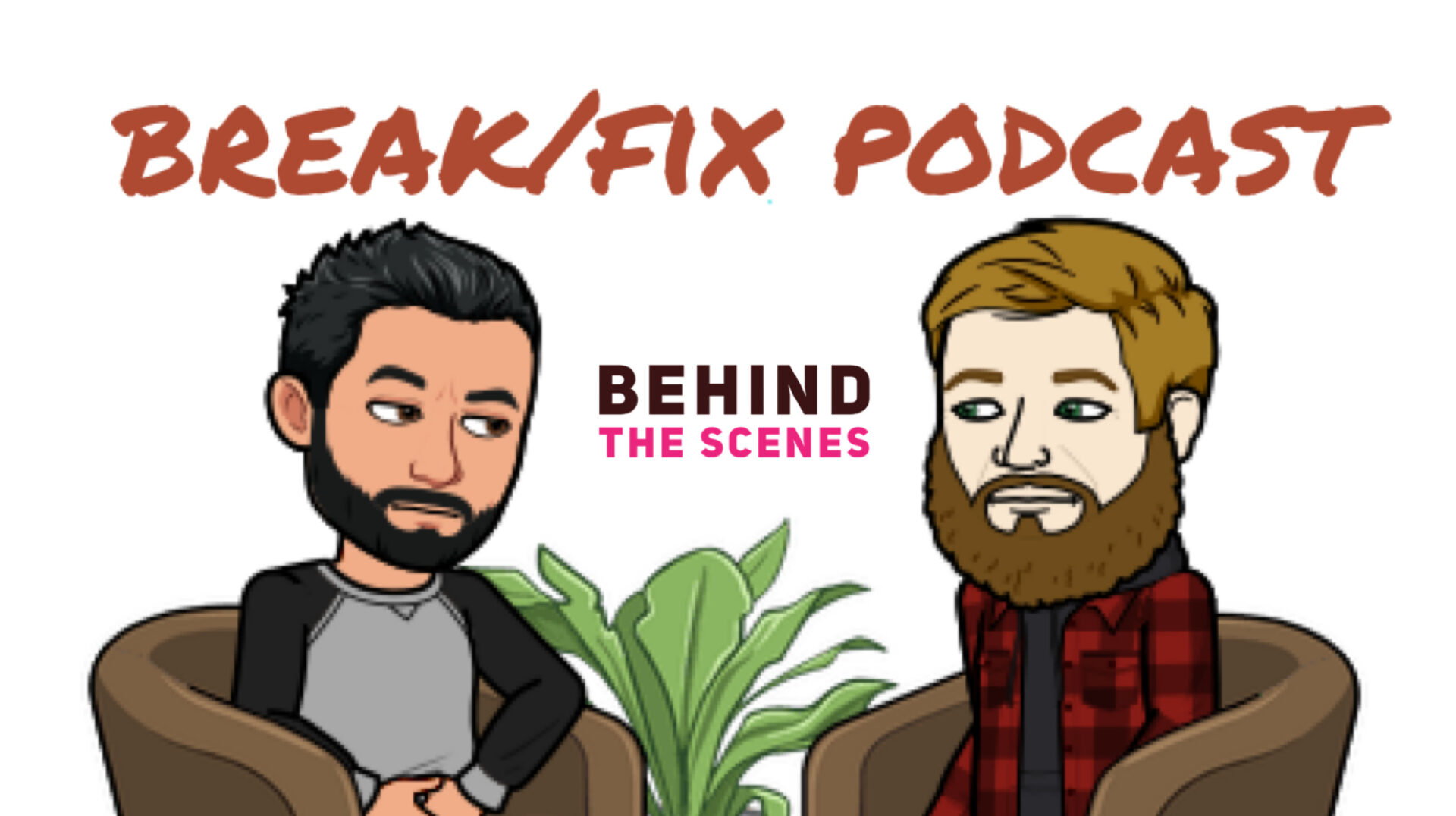
Consider becoming a GTM Patreon Supporter and get behind the scenes content and schwag!
Do you like what you've seen, heard and read? - Don't forget, GTM is fueled by volunteers and remains a no-annual-fee organization, but we still need help to pay to keep the lights on... For as little as $2.50/month you can help us keep the momentum going so we can continue to record, write, edit and broadcast your favorite content. Support GTM today! or make a One Time Donation.

If you enjoyed this episode, please go to Apple Podcasts and leave us a review. That would help us beat the algorithms and help spread the enthusiasm to others by way of Break/Fix and GTM. Subscribe to Break/Fix using your favorite Podcast App:
 |  |  |
Christi Schimpke, the founder of CRASH Jewelry, came up with the idea to create fashion jewelry from cars when she moved her studio into her husband’s Los Angeles body shop, Beverly Coachcraft, which specializes in collision repairs for late-model European cars.
To learn more about Christi and CRASH, be sure to logon to www.crashjewelry.com or follow her on social media @crashjewlry on Instagram & Facebook, Twitter, or Pinterest; and you can connect with her on LinkedIn.
There’s more to this story…
Check out the Behind the Scenes tour of the CRASH Jewelry facility given by founder Christi Schimpke. For more behind the scenes, Pit Stop minisodes and other goodies, check out our Patreon.
Guest Co-Host: Lauren Goodman
In case you missed it... be sure to check out the Break/Fix episode with our co-host. |  |  |


